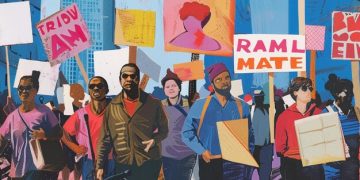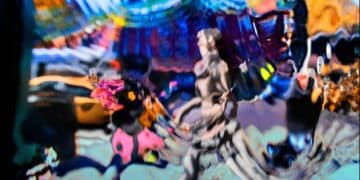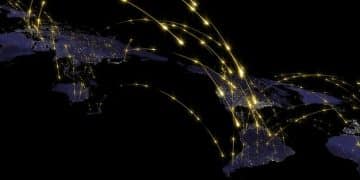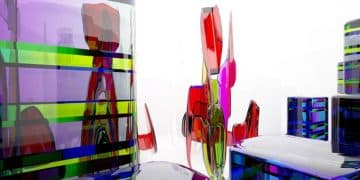AI Art Copyright in the US: Legal Updates & Future Implications
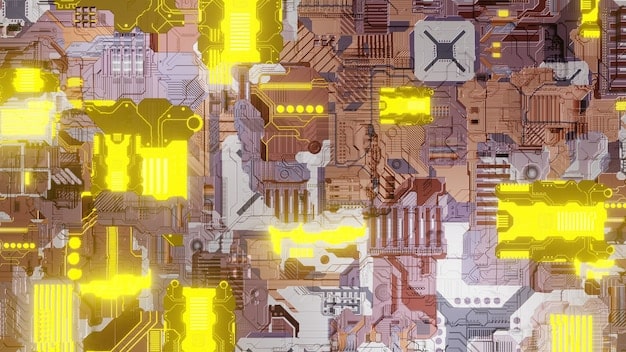
Can AI-generated art be copyrighted in the US? The answer is complex, with recent court decisions suggesting that art entirely created by artificial intelligence, lacking human authorship, cannot be copyrighted, raising significant legal and ethical questions for artists and developers alike.
The rise of artificial intelligence has brought about a new era in art creation, challenging traditional notions of authorship and copyright. The question of whether can AI-generated art be copyrighted in the US? Recent Updates and Legal Implications has become a focal point for legal scholars, artists, and tech developers alike.
Understanding Copyright Law and AI-Generated Art
Copyright law in the United States is designed to protect original works of authorship. This protection extends to various forms of creative expression, including literary, dramatic, musical, and certain other intellectual works.
However, the application of copyright law to AI-generated art is where the legal waters become murky. The core issue revolves around the requirement of human authorship.
The Human Authorship Requirement
For a work to be copyrightable, it must have a human author. This principle is deeply rooted in the history and purpose of copyright law.
- Originality: The work must be original, meaning it is independently created by a human author and possesses at least some minimal degree of creativity.
- Authorship: The author must be a human being. Non-human entities, such as animals or machines, cannot be authors for copyright purposes.
- Fixed Form: The work must be fixed in a tangible medium of expression, such as a painting, a sculpture, a photograph, or a digital file.
AI-generated art often lacks this human element, as the creative process is driven by algorithms and machine learning models. This raises the question: if a machine creates the art, who is the author?
In essence, the current legal framework in the US emphasizes the need for human creativity and intervention for a work to qualify for copyright protection. This stance poses significant challenges to artists and developers who utilize AI in their creative processes.
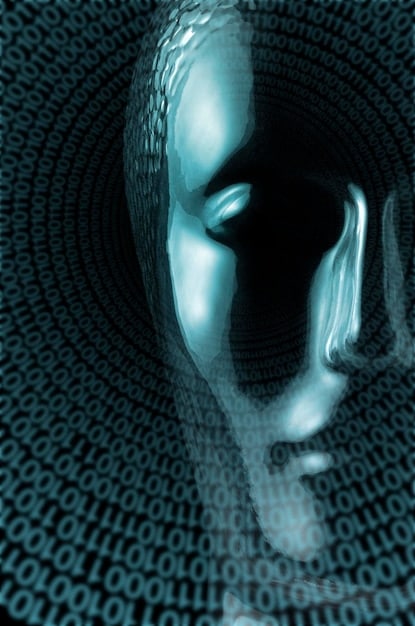
Recent Court Decisions and the Copyright Office’s Stance
Recent court decisions have provided clarity on the copyrightability of AI-generated art in the US. These decisions, along with guidance from the US Copyright Office, have shaped the current legal landscape.
The Copyright Office has been consistent in its view that works created solely by artificial intelligence are not protected by copyright. This position is based on the long-standing requirement of human authorship.
The “Zarya of the Dawn” Case
One notable case that has garnered significant attention is the “Zarya of the Dawn” case. In this instance, the Copyright Office initially granted copyright protection to a comic book that included images generated with the help of AI.
However, the Office later clarified its position, stating that while the human author could claim copyright over the arrangement and selection of the AI-generated images, the individual images themselves were not copyrightable because they lacked human authorship.
Key Takeaways from the Copyright Office
The Copyright Office’s stance can be summarized as follows:
- Works created entirely by AI are not eligible for copyright protection.
- Human authors can claim copyright over original arrangements or modifications of AI-generated elements.
- The focus is on the degree of human input and creativity in the final work.
These guidelines have significant implications for artists who use AI tools in their creative process. It underscores the importance of human intervention and originality in establishing copyright ownership.
The courts and the Copyright Office are treading carefully to balance technological innovation with established principles of copyright law. Ensuring that human creativity remains at the heart of copyright protection is a key consideration.
The Role of Human Input and Creativity
Given the legal requirement for human authorship, the extent of human input and creativity plays a crucial role in determining whether AI-generated art can be copyrighted.
When a human artist significantly modifies or transforms AI-generated content, the resulting work may be eligible for copyright protection.
Transformative Use and Copyright
Transformative use occurs when a work is altered in such a way that it becomes a new and original creation. Courts often consider transformative use when assessing copyright infringement claims.
For AI-generated art, transformative use could involve:
- Extensive editing, manipulation, or combination of AI-generated elements.
- Adding original artwork, text, or other creative components.
- Using AI-generated content as a starting point for a larger artistic project.
Examples of Copyrightable AI-Assisted Art
Consider the following scenarios where AI-generated art might be eligible for copyright protection:
- An artist uses AI to generate several background images and then manually paints over them, adding significant details and original elements.
- A graphic designer uses AI to create a series of textures and patterns, which are then incorporated into a complex and unique design.
- A musician uses AI to generate musical phrases, which are then arranged, modified, and combined with original compositions.
In each of these cases, the human artist has contributed significant creative input, transforming the AI-generated content into a new and original work. The level of human involvement is what differentiates copyrightable art from uncopyrightable AI output.
The key is to demonstrate that the human artist has added substantial creative input, transforming the AI-generated elements into something new and original. This balance between AI assistance and human creativity is central to determining copyright eligibility.
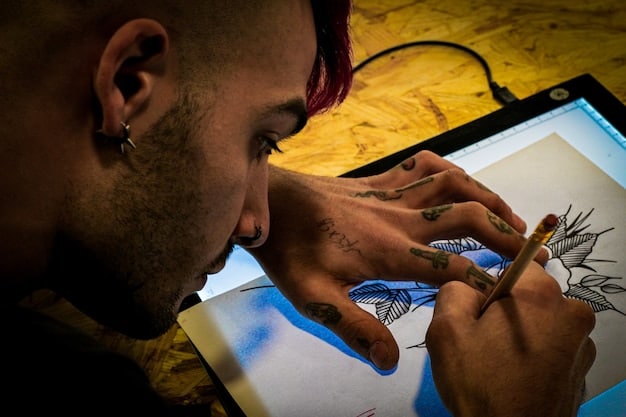
Ethical Considerations and the Future of AI Art
Beyond the legal aspects, the rise of AI-generated art raises important ethical considerations about creativity, authorship, and the role of machines in artistic expression.
As AI models become more sophisticated, the lines between human and machine creativity become increasingly blurred.
The Impact on Human Artists
One concern is the potential impact on human artists. If AI can generate art that rivals or even surpasses human creations, what will become of human artists?
Several possible outcomes may arise:
- Artists may need to adapt and learn to work with AI tools, rather than competing against them.
- The value of human-created art may increase due to its unique and irreplaceable nature.
- New forms of art may emerge that blend human and machine creativity in novel ways.
Questions of Authenticity and Originality
Another ethical consideration is the question of authenticity and originality. If the art is generated by a machine, can it truly be original?
Some argue that true originality requires human consciousness, emotion, and experience. Others contend that AI can create original works in its own right, even if those works are based on algorithms and data.
The development of AI in art challenges us to redefine what we mean by creativity and originality. It also prompts us to consider the unique contributions that humans bring to the creative process.
Ultimately, the future of AI and art will depend on how we choose to integrate these technologies into our creative practices. Balancing innovation with ethical considerations will be essential.
Practical Implications for Artists and Developers
For artists and developers working with AI-generated art, understanding the legal and ethical implications is crucial for navigating this evolving landscape.
Here are some practical steps to consider:
Documenting Human Input
Artists should carefully document their own creative input into AI-generated works. This documentation can serve as evidence of human authorship if copyright claims are challenged.
Using AI as a Tool
Frame AI as a tool that enhances human creativity, rather than a replacement for it. Emphasize how the artist uses AI to bring their unique vision to life.
Licensing and Terms of Use
Developers of AI art tools should clearly define the terms of use and licensing agreements. Explain what rights artists have when using the tool and whether the AI-generated output can be copyrighted.
Exploring New Creative Avenues
Embrace the possibilities that AI offers for exploring new creative avenues. Use AI as a source of inspiration and experimentation, while preserving human agency and originality.
By adopting these practices, artists and developers can navigate the legal and ethical complexities of AI-generated art. Fostering a culture of transparency and collaboration will be key to ensuring that AI serves as a force for good in the art world.
The Future Legal Landscape of AI Art
As AI technology continues to advance, the legal landscape surrounding AI-generated art will undoubtedly evolve. It’s essential to anticipate and prepare for potential changes.
Several possible developments could shape the future of AI art and copyright law:
Legislative Updates
Lawmakers may introduce new legislation specifically addressing AI-generated art. These laws could clarify the requirements for copyright protection and establish guidelines for human authorship.
Court Precedents
Future court cases will likely further refine the legal principles governing AI art. These precedents could establish clearer standards for determining copyright ownership.
International Harmonization
Efforts to harmonize copyright laws across different countries could also impact the legal framework for AI art. International agreements could help ensure consistent treatment of AI-generated works.
Technological Advancements
Advancements in AI technology itself could also influence the legal landscape. As AI models become more sophisticated, the question of whether they can be considered “authors” may become more pressing.
Staying informed about these developments will be crucial for artists, developers, and legal professionals. Adapting to the evolving legal and technological landscape will be key to ensuring that the art world remains vibrant and innovative.
| Key Point | Brief Description |
|---|---|
| 🖼️ Human Authorship | Copyright requires human authorship; AI-generated art alone can’t be copyrighted. |
| 🤖 AI as a Tool | AI should be seen as a tool to enhance human creativity, not replace it. |
| ⚖️ Ethical Concerns | AI art raises ethical questions about originality and the impact on human artists. |
| 📝 Document Input | Artists should document their input to AI art for potential copyright claims. |
Frequently Asked Questions
▼
No, according to current U.S. copyright law, art generated solely by artificial intelligence cannot be copyrighted, as it lacks human authorship, which is a fundamental requirement.
▼
If a human significantly modifies or transforms AI-generated art, the resulting work may be eligible for copyright. The key is demonstrating substantial human creative input.
▼
The amount of human input needed isn’t precisely defined, but it should be substantial enough to demonstrate that the final work is primarily a product of human creativity and not solely AI.
▼
Artists can document their creative process, emphasize their unique vision, and use AI as a tool to enhance, rather than replace, their artistic abilities to strengthen potential copyright claims.
▼
Yes, ethical questions arise regarding originality, authenticity, and the potential impact of AI art on human artists, prompting discussions about the future of creativity and authorship.
Conclusion
In conclusion, while the question can AI-generated art be copyrighted in the US? Recent Updates and Legal Implications remains a complex one, the prevailing stance is that copyright protection requires significant human input and creativity. As AI continues to evolve, artists and developers must navigate the legal and ethical considerations carefully to ensure that human originality remains at the heart of art creation.
